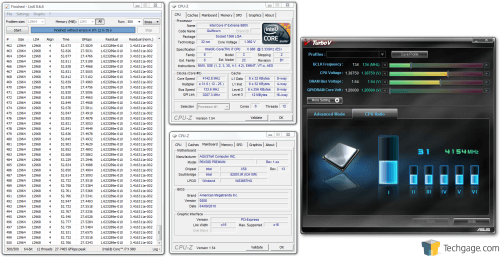- Qualcomm Launches Snapdragon 4 Gen 2 Mobile Platform
- AMD Launches Ryzen PRO 7000 Series Mobile & Desktop Platform
- Intel Launches Sleek Single-Slot Arc Pro A60 Workstation Graphics Card
- NVIDIA Announces Latest Ada Lovelace Additions: GeForce RTX 4060 Ti & RTX 4060
- Maxon Redshift With AMD Radeon GPU Rendering Support Now Available
ASUS P6X58D Premium

Intel may have launched its X58 chipset nearly a year-and-a-half ago, but board vendors continue to come out with new product as technologies improve. This past winter, ASUS released the P6X58D Premium, a high-end offering that boasts support for both SATA 3.0 and USB 3.0, and one that just begs to be pushed hard with overclocking.
Page 8 – Overclocking the P6X58D Premium
Before tackling our overclocking results, let’s first clear up what we consider to be a real overclock and how we go about achieving it. If you regularly read our processor reviews, you may already be aware that I personally don’t care for an unstable overclock. It might look good on paper, but if it’s not stable, then it won’t be used. Very few people purchase a new piece of equipment for the sole purpose of finding the maximum overclock, which is why we focus on finding what’s stable and usable.
To help find the maximum stable overclock on any given motherboard, we focus on sticking to the simpler voltages, such as the ones for the Northbridge and CPU, and also the DIMM if it’s required. We try to work within safe limits, because anything too high is going to only kill your hardware faster. Luckily, all computer components nowadays are designed to handle some abuse, so you never need a lot of voltage to get anywhere.
With Core i7, more factors can come into play with overclocking, but we focus on increasing the Base Clock first and foremost, just like we focus on the Front-Side Bus on Core 2 motherboards. Our goal is to keep voltages are low as possible while reaching the highest stable overclock. Areas where we will increase voltage if needed is the CPU, Northbridge and QPI.
Overclocking ASUS’ P6X58D Premium
As mentioned on the intro page, although we benchmarked with our Core i7-965 for the performance results, we popped in the Core i7-980X for the sake of overclocking since it’s newer, and overclocks a lot better than our early-silicon i7-965 does. When I overclock, I usually try to go as far as I can without touching the voltage, but for the sake of this article, I wanted to fore go that idea and just see how far I could go while not going overboard on the voltage.
After a fair amount of tinkering, I found the sweet spot to be around 1.36V for the voltage (ASUS’ tuner software states 1.38750V, but CPU-Z shows the more likely value to be 1.36V) which allowed a fully stable 4.14GHz overclock. At that clock speed, it’s nearly 100MHz more than what we saw with Gigabyte’s X58A-UD5, which we used for the sake of benchmarking the Core i7-980X in our launch article.
The P6X58D Premium’s sole purpose might not be for overclocking, but as evidenced here, it can push a six-core CPU to a fully stable 4.14GHz overclock, so I’d consider that impressive. I have doubts that many people would even want to go much past this, but if you do want to spend the time with tweaking, you could likely get it even higher.
Support our efforts! With ad revenue at an all-time low for written websites, we're relying more than ever on reader support to help us continue putting so much effort into this type of content. You can support us by becoming a Patron, or by using our Amazon shopping affiliate links listed through our articles. Thanks for your support!






